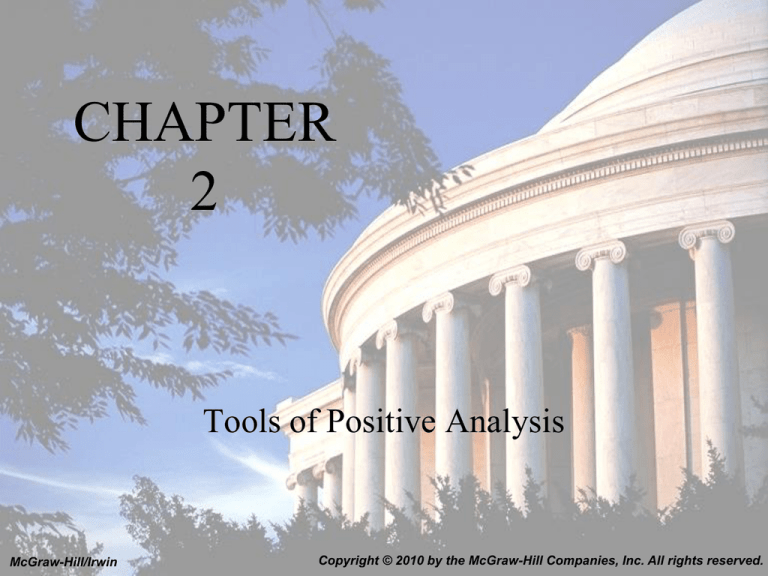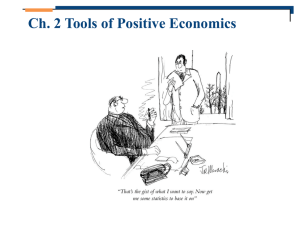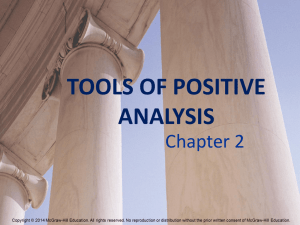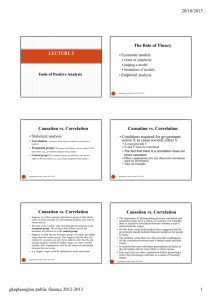
CHAPTER
2
Tools of Positive Analysis
McGraw-Hill/Irwin
1-1
Copyright © 2010 by the McGraw-Hill Companies, Inc. All rights reserved.
Tools for Positive Analysis
• Do tax rates have an effect on work effort.?
• Does environmental restrictions improve
health outcomes?
• Do school vouchers improve students’ test
scores?
• This chapter discusses the tools that
economists use to estimate the impact of
government programs on individual behavior.
2-2
The Role of Theory
• Economic models
– Virtue of simplicity(economic models are not
realistic)
– Judging a model
– Limitations of models
• Ex: Simple Labor Supply Model
• Empirical analysis is necessary to find out
individual behavior.
2-3
Causation vs. Correlation
• Statistical analysis
– Correlation( a measure of the extent to which two events move
together)
– Control group(comparison group of individuals who are not
subject to the intervention being)
– Treatment group(studied.the group of individuals who are
subject to intervention being studied)
• Conditions required for government action X to cause societal effect
Y
– X must precede Y
– X and Y must be correlated
– Other explanations for any observed correlation must be
eliminated
2-4
Causation vs. Correlation
• It is found out that married people have higher wages. So
there is a correlation between being married and having higher
wages.
• Is it reasonable for government to institute financial incentives
for people to marry?
2-5
Experimental Studies
• Biased estimates(a different estimate than the
true relationship)
• Counterfactual(the outcome for people in the
treatment group had they not being treated.
• Experimental (or randomized) study (subjects
are randomly assigned to be in the treatment or
control group).
2-6
Conducting an Experimental Study
• Random assignment to control and treatment
groups
• Ex: UI and unemployment duration.
Random assignment of individuals to high UI or
low UI.
As sample size increase all the characteristics of
high UI and low UI groups will converge.
2-7
Pitfalls of Experimental Studies
• Ethical issues
• Technical problems(people are not passive
objects)
• Response bias(some people do not respond)
• Impact of limited duration of experiment
• Generalization of results to other populations,
settings, and related treatments
• Black box aspect of experiments
2-8
Observational Studies
• Observational study – empirical study relying
on observed data not obtained from
experimental study
• Sources of observational data
– Surveys(household budget survey)
– Administrative records(hospital records on birth)
– Governmental data(tax revenue data)
• Econometrics
– Regression analysis
2-9
Conducting an Observational Study
• L = α0 + α1wn + α2X1 + … + αnXn + ε
– Dependent variable
L
– Independent variables
– Parameters
– Stochastic error term
• Regression analysis
– Regression line
Slope
– Standard error
is α1
Intercept
is α0
α0
wn
2-10
Types of Data
• Cross-sectional data
• Time-series data
• Panel data
2-11
Pitfalls of Observational Studies
• Data collected in non-experimental setting
In wage and labor supply example, the reason why higher wage
earners work more can be explained by higher wage earner
being more ambitious people. So, the difference in hours
worked is not due to wage but it is due to ambition.
In regression analysis we try to add any variable that might effect
hours worked as independent variable, such as ……?
Specification issues
type of relationship can be misspecified. (linear
vs non-linear.
2-12
Quasi-Experimental Studies
• Quasi-experimental study (= natural
experiment) – observational study relying on
circumstances outside researcher’s control to
mimic random assignment
Uses observational data but there is random
assignment.
2-13
Conducting a Quasi-Experimental Study
• Difference-in-Difference quasi-experiments
• Example: tax on beer and reduction in teen
traffic fatalities) some states increased tax
from 89-92 and some states did not.
• Instrumental Variables quasi-experiments
• Regression-Discontinuity quasi-experiments
2-14
Pitfalls of Quasi-Experimental
Studies
• Assignment to control and treatment groups
may not be random
• Not applicable to all research questions
• Generalization of results to other settings and
treatments
2-15





